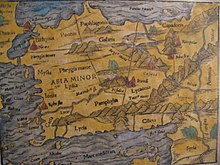Bithynia
| |||||||||||||||||||
Read other articles:

Untuk kegunaan lain, lihat laki-laki. Perisai dan lembing untuk dewa Romawi Mars, sering digunakan untuk melambangkan jenis kelamin jantan dan laki-laki. Jantan adalah jenis kelamin sesuatu ataupun sebagian organisme yang menghasilkan sperma. Sperma merupakan gamet yang lebih kecil dalam sistem pembiakan heterogami dan biasanya bergerak dan berupaya mensenyawakan ovum, yaitu gamet betina. Jantan tidak bisa berkembang biak tanpa gamet betina. Tidak ada satu mekanisme genetik yang tunggal di belak…

ХристианствоБиблия Ветхий Завет Новый Завет Евангелие Десять заповедей Нагорная проповедь Апокрифы Бог, Троица Бог Отец Иисус Христос Святой Дух История христианства Апостолы Хронология христианства Раннее христианство Гностическое христианство Вселенские соборы Ни�…

artikel ini tidak memiliki pranala ke artikel lain. Tidak ada alasan yang diberikan. Bantu kami untuk mengembangkannya dengan memberikan pranala ke artikel lain secukupnya. (Pelajari cara dan kapan saatnya untuk menghapus pesan templat ini) Artikel ini sebatang kara, artinya tidak ada artikel lain yang memiliki pranala balik ke halaman ini.Bantulah menambah pranala ke artikel ini dari artikel yang berhubungan atau coba peralatan pencari pranala.Tag ini diberikan pada Desember 2022. Farmakologi T…

English academic and Catholic priest This biography of a living person needs additional citations for verification. Please help by adding reliable sources. Contentious material about living persons that is unsourced or poorly sourced must be removed immediately from the article and its talk page, especially if potentially libelous.Find sources: Aidan Nichols – news · newspapers · books · scholar · JSTOR (September 2016) (Learn how and when to remove this …

Religion of Japanese origin originating in Shinbutsu-shūgō beliefs This article has multiple issues. Please help improve it or discuss these issues on the talk page. (Learn how and when to remove these template messages) This article relies excessively on references to primary sources. Please improve this article by adding secondary or tertiary sources. Find sources: Konkokyo – news · newspapers · books · scholar · JSTOR (October 2023) (Learn how and wh…

Comics character Bronze TigerBronze Tiger as depicted on the cover to Checkmate #7. Art by Cliff Richards.Publication informationPublisherDC ComicsFirst appearanceRichard Dragon, Kung Fu Fighter #1 (May 1975)Created byDennis O'Neil (writer)Jim Berry (artist)Leopoldo Durañona (artist)In-story informationAlter egoBenjamin Ben TurnerSpeciesHumanPlace of originCentral CityTeam affiliationsSuicide SquadLeague of AssassinsG.O.O.D.Justice League Task ForceJustice LeagueCBIPartnershipsRichard DragonLad…

British intelligence officer and Soviet double agent (1912–1988) Kim PhilbyPhilby in 1955BornHarold Adrian Russell Philby(1912-01-01)1 January 1912Ambala, Punjab, British IndiaDied11 May 1988(1988-05-11) (aged 76)Moscow, Russian SFSR, Soviet UnionBurial placeKuntsevo CemeteryRyabinovaya Ulitsa, Moscow[1]NationalityBritish, SovietEducationWestminster SchoolAlma materTrinity College, CambridgeSpousesLitzi FriedmannAileen FurseEleanor BrewerRufina Ivanovna PukhovaParentsSt John …

A Republikanska futbolna grupa 1959-1960 Competizione A Profesionalna Futbolna Grupa Sport Calcio Edizione 36ª Organizzatore BFS Date dal 14 agosto 1959al 2 luglio 1960 Luogo Bulgaria Partecipanti 12 Risultati Vincitore CSKA Sofia(10º titolo) Promozioni Spartak Sofia Septemvri Sofia Retrocessioni Spartak Pleven Statistiche Miglior marcatore Dimitar Yordanov (12) Lyuben Kostov (12) Incontri disputati 132 Gol segnati 338 (2,56 per incontro) Cronolog…
هذه المقالة بحاجة لصندوق معلومات. فضلًا ساعد في تحسين هذه المقالة بإضافة صندوق معلومات مخصص إليها.Learn how and when to remove this message صناعة التلفزيون هي كل ما يتعلق بالعمل التلفزيوني سواء بشكل تقني أو هندسي أوفني أو بشكل داعم أو إداري أو ما يتعلق بالصناعات المجاورة، كصناعة الإعلان أوال�…

This article relies excessively on references to primary sources. Please improve this article by adding secondary or tertiary sources. Find sources: 2024 Copa América de Futsal squads – news · newspapers · books · scholar · JSTOR (May 2024) (Learn how and when to remove this message) The 2024 Copa América de Futsal is an international futsal tournament to be held in Luque, Paraguay from 2 to 10 February 2024. The ten national teams involved in the tourn…

Chemical compound Not to be confused with cannabinol or cannabidiol. CannabinodiolClinical dataATC codeNoneLegal statusLegal status CA: Schedule II UK: Under Psychoactive Substances Act Identifiers IUPAC name 5'-Methyl-4-pentyl-2'-(prop-1-en-2-yl)-[1,1'-biphenyl]-2,6-diol CAS Number39624-81-2 YPubChem CID11551346ChemSpider9726124UNIICNY5ZTN8E3CompTox Dashboard (EPA)DTXSID401045922 Chemical and physical dataFormulaC21H26O2Molar mass310.437 g·mol−13D model (JSmol)Interactive…

German motorcycle racer This article has multiple issues. Please help improve it or discuss these issues on the talk page. (Learn how and when to remove these template messages) The topic of this article may not meet Wikipedia's notability guideline for sports and athletics. Please help to demonstrate the notability of the topic by citing reliable secondary sources that are independent of the topic and provide significant coverage of it beyond a mere trivial mention. If notability cannot be show…

This article needs additional citations for verification. Please help improve this article by adding citations to reliable sources. Unsourced material may be challenged and removed.Find sources: The Don's Analyst – news · newspapers · books · scholar · JSTOR (April 2020) (Learn how and when to remove this message) 1997 American filmThe Don's AnalystDirected byDavid JablinWritten byDavid HurwitzProduced byDavid JablinJames P. JimirroLarry RapaportStarringK…

The God of High SchoolGambar sampul volume pertama The God of High School yang menampilkan Jin Mo-Ri갓 오브 하이 스쿨(Gat Obeu Hai Seukul)GenreLaga[1]PengarangYongje ParkPenerbitImageframeLayanan webtunNaver Webtoon (Korea)LINE Webtoon (Indonesia)Terbit8 April 2011 – sekarangVolume1Seri animeSutradaraPark Sunghoo[a]ProduserSae Whan SongJoseph ChouSaechanSkenarioKiyoko YoshimuraMusikArisa OkehazamaStudioMAPPAPelisensiSEA Muse AsiaEU/NA CrunchyrollSaluranasliToky…

Industrialist and terminologistYou can help expand this article with text translated from the corresponding article in Esperanto. Click [show] for important translation instructions. Machine translation, like DeepL or Google Translate, is a useful starting point for translations, but translators must revise errors as necessary and confirm that the translation is accurate, rather than simply copy-pasting machine-translated text into the English Wikipedia. Do not translate text that appears unreli…

Wife of German poet Friedrich Schiller Print of a portrait of Charlotte von Lengefeld, probably by Auguste Christian Fleischman. Charlotte Luise Antoinette von Schiller (née von Lengefeld; 22 November 1766 – 9 July 1826) was the wife of German poet Friedrich Schiller. Early life Lengefeld was born in Rudolstadt, Schwarzburg-Rudolstadt, into an aristocratic family, and given an education appropriate to a life at the ducal court of Weimar.[1] Her father Carl Christoph von Lengefeld …

Former settlement in England Calleva AtrebatumSite plan of Calleva Atrebatum, drawn before 1911Shown within HampshireAlternative nameSilchester Roman TownLocationSilchester, Hampshire, EnglandRegionBritanniaCoordinates51°21′26″N 1°4′57″W / 51.35722°N 1.08250°W / 51.35722; -1.08250TypeSettlementPart ofBritannia, Britannia Superior, then Britannia PrimaAreaApproximately 40 ha (99 acres)HistoryBuilderAtrebates tribeFoundedLate 1st century BCAbandon…

English noblewoman and courtier For other people with the same name, see Anne Herbert (disambiguation). The Countess of PembrokeAnne Herbert, Countess of Pembroke depicted in a stained glass window at Wilton Parish Church.Born15 June 1515London, EnglandDied20 February 1552 (aged 36)Baynard's Castle, London, England[1]BuriedSt Paul's Cathedral, City of LondonSpouse(s)William Herbert, 1st Earl of PembrokeIssueHenry Herbert, 2nd Earl of PembrokeSir Edward HerbertLady Anne HerbertFatherSir T…

Johanna Uerieta Gertze (née Kazahendike) (Otjimbingwe, 16 July 1836 – 3 July 1935, Otjimbingwe) was a Namibian Herero and Christian convert. Gertze worked in the household of Carl Hugo Hahn and his wife at Otjikango. She initially came to the school at the mission to learn sewing and soon became so proficient that she was teaching the art to others. She appears to have been fluent in English, Dutch, and German, and she assisted in translating a variety of materials into Herero. Between 1860 a…

Office skyscrapter in Sydney, Australia Aurora PlaceGeneral informationTypeCommercial skyscraperLocation88 Phillip Street, Sydney, AustraliaConstruction started1998Completed2000HeightArchitectural218 m (715 ft)Roof188 m (617 ft)Technical detailsFloor count41Floor area49,500 m2 (533,000 sq ft)Design and constructionArchitect(s)Renzo Piano Building Workshop in association with Innovarchi Architects, Sydney and Lend Lease DesignDeveloperLendleaseStructural enginee…




